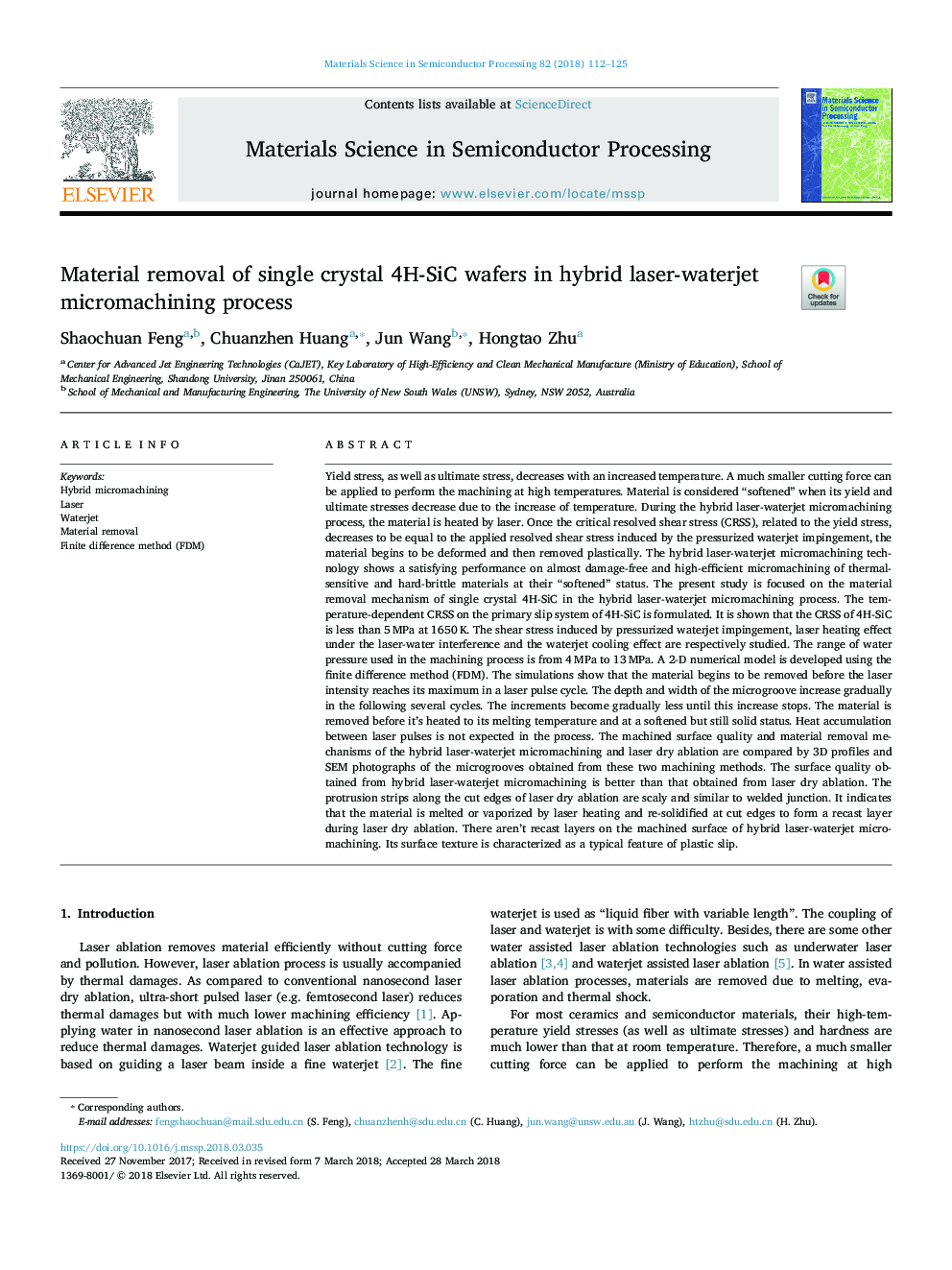| کد مقاله | کد نشریه | سال انتشار | مقاله انگلیسی | نسخه تمام متن |
|---|---|---|---|---|
| 7117650 | 1461365 | 2018 | 14 صفحه PDF | دانلود رایگان |
عنوان انگلیسی مقاله ISI
Material removal of single crystal 4H-SiC wafers in hybrid laser-waterjet micromachining process
دانلود مقاله + سفارش ترجمه
دانلود مقاله ISI انگلیسی
رایگان برای ایرانیان
موضوعات مرتبط
مهندسی و علوم پایه
سایر رشته های مهندسی
مهندسی برق و الکترونیک
پیش نمایش صفحه اول مقاله

چکیده انگلیسی
Yield stress, as well as ultimate stress, decreases with an increased temperature. A much smaller cutting force can be applied to perform the machining at high temperatures. Material is considered “softened” when its yield and ultimate stresses decrease due to the increase of temperature. During the hybrid laser-waterjet micromachining process, the material is heated by laser. Once the critical resolved shear stress (CRSS), related to the yield stress, decreases to be equal to the applied resolved shear stress induced by the pressurized waterjet impingement, the material begins to be deformed and then removed plastically. The hybrid laser-waterjet micromachining technology shows a satisfying performance on almost damage-free and high-efficient micromachining of thermal-sensitive and hard-brittle materials at their “softened” status. The present study is focused on the material removal mechanism of single crystal 4H-SiC in the hybrid laser-waterjet micromachining process. The temperature-dependent CRSS on the primary slip system of 4H-SiC is formulated. It is shown that the CRSS of 4H-SiC is less than 5â¯MPa at 1650â¯K. The shear stress induced by pressurized waterjet impingement, laser heating effect under the laser-water interference and the waterjet cooling effect are respectively studied. The range of water pressure used in the machining process is from 4â¯MPa to 13â¯MPa. A 2-D numerical model is developed using the finite difference method (FDM). The simulations show that the material begins to be removed before the laser intensity reaches its maximum in a laser pulse cycle. The depth and width of the microgroove increase gradually in the following several cycles. The increments become gradually less until this increase stops. The material is removed before it's heated to its melting temperature and at a softened but still solid status. Heat accumulation between laser pulses is not expected in the process. The machined surface quality and material removal mechanisms of the hybrid laser-waterjet micromachining and laser dry ablation are compared by 3D profiles and SEM photographs of the microgrooves obtained from these two machining methods. The surface quality obtained from hybrid laser-waterjet micromachining is better than that obtained from laser dry ablation. The protrusion strips along the cut edges of laser dry ablation are scaly and similar to welded junction. It indicates that the material is melted or vaporized by laser heating and re-solidified at cut edges to form a recast layer during laser dry ablation. There aren't recast layers on the machined surface of hybrid laser-waterjet micromachining. Its surface texture is characterized as a typical feature of plastic slip.
ناشر
Database: Elsevier - ScienceDirect (ساینس دایرکت)
Journal: Materials Science in Semiconductor Processing - Volume 82, 1 August 2018, Pages 112-125
Journal: Materials Science in Semiconductor Processing - Volume 82, 1 August 2018, Pages 112-125
نویسندگان
Shaochuan Feng, Chuanzhen Huang, Jun Wang, Hongtao Zhu,